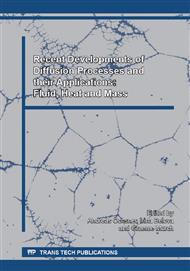[1]
Nanomateriaux, O.F.T.A. Paris Octobre 2001J. Clerk Maxwell, A Treatise on Electricity and Magnetism, 3rd ed., vol. 2. Oxford: Clarendon, 1892, p.68–73.
Google Scholar
[2]
Eric Gaffet, Michel Froment-Vedrine Directrice de AFSEET, les nanomatériaux effet sur la santé de l'homme et l'environnement, juillet (2006).
Google Scholar
[3]
C. Suryanarayana, Mechanical alloying and milling, Progress in Materiel Science 46(2001).
Google Scholar
[4]
Gaffet et le Caer, 2004. Mechanical processing for nanomaterials. Encyclopedia of nanoscience and nanotechnology, American Scientific Publishers, 5 91, 129.
Google Scholar
[5]
C. Suryanarayana, Nasser Alaqeel, Prog. Mat. Scien, 58(2013) 383-502.
Google Scholar
[6]
G. E Fougere, J.R. Weertman, and R. W Siegel – Processing and Mechanical Behavior of Nanocrystalline Fe – NanoStructured Materials, Vol 5, pp.127-134, (1995).
DOI: 10.1016/0965-9773(95)00021-6
Google Scholar
[7]
A. Latapie, D. Farkas - Effect of grain size on the elastic properties of nanocrystallie α-iron, Scripta Materiallia 48 (2003) 611-615.
DOI: 10.1016/s1359-6462(02)00467-0
Google Scholar
[8]
Hong Son Cao, Jean Jacques hunsinger, Régis Bonnet- Matériaux (2002).
Google Scholar
[9]
O. Elkedim, H. S Cao, D. Guay – Journal of Mat. Proces. Tech 121 (2002) 383-389.
Google Scholar
[10]
D. Martinez-Blanco, P. Gorria- Nanostructred Fe obtained by high energy ball milling-JMMM(2006).
Google Scholar
[11]
Mohsen Mhadbi, Mohamed Khitouni- Materials characterization (2008).
Google Scholar
[12]
R.K. Khartikar, B, S. Marty- Material chemistry and Physics (2010).
Google Scholar
[13]
Rabah Hamzaoui, NourEddine Fenineche and Omar Elkedim – Composition effect on the magnetic properties of nanocrystalline Fe-Co alloys (UTBM) – Matériaux (2002).
Google Scholar
[14]
S. BERGHEUL, A. HADDAD, H. TAFAT and M. AZZAZ «Magnetic, Microwave and Absorbing Properties Fe-Co of Alloy synthesized by Mechanical Alloying Process»-European Corrosion Congress September 2005 • Instituto Superior Téchnico • Lisbon, Portugal.
DOI: 10.1504/ijmmp.2006.011648
Google Scholar
[15]
G.K. Williamson and W.H. Hall-Acta metallurgica, Vol. 1 Jan. (1953).
Google Scholar
[16]
Pierre Graverraux -Cel 00671294 version 1-17, Fev 2012 ICMCB-CNRS, Université Bordeaux1.
Google Scholar
[17]
D. Kim, E. S Vasilieva, A. G Nasibulin – Material Science Forum, TTP 2007, Switzerland.
Google Scholar
[18]
G. Herzer, Nanocrystalline soft magnetic materials (A), Physica Scripta vol. T49, pp.307-314, (1993).
DOI: 10.1088/0031-8949/1993/t49a/054
Google Scholar
[19]
G. Herzer, Nanocrystalline soft magnetic alloys, dans: Handbook of magnetic materials, vol. 10, edited by K. H. J. Buschow (1997).
Google Scholar


